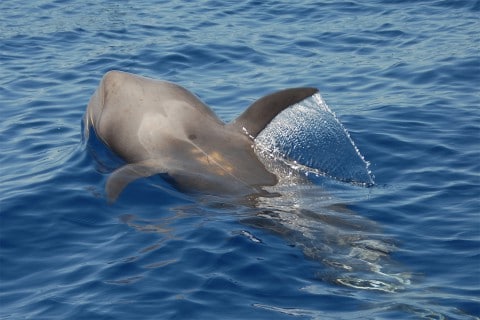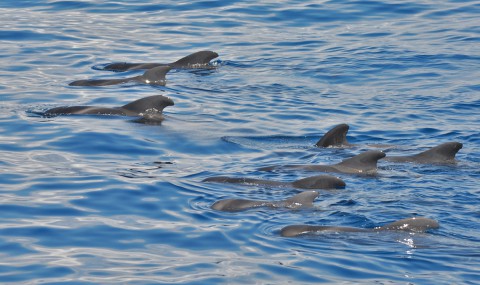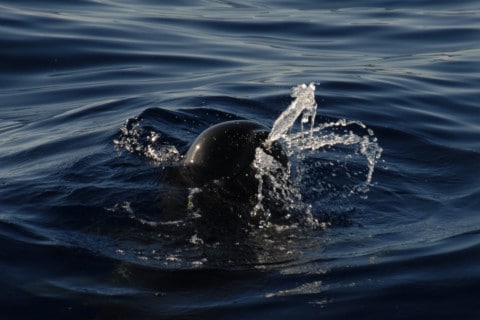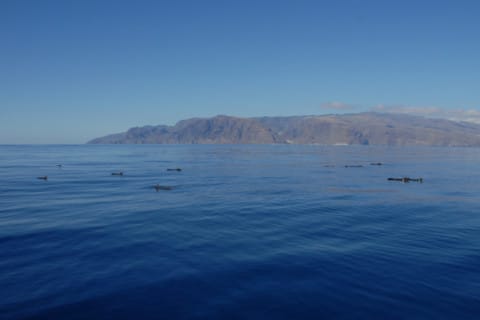The pilot whales (Globicephala macrorhynchus) are the most common cetaceans in the Canary Islands. The population is estimated at 2000 individuals living permanently in the Canary Islands.
Overview:
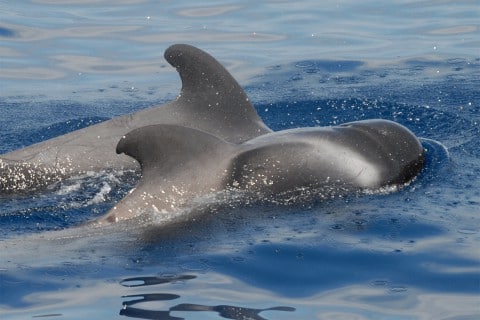
Stable population 2000 animals, very frequent
3 – 5 miles off the coast
Size: 400 (female) – 550 cm (male)
weight: 600 – 2000 kg
Prey: fish and squid
colour: dark grey-brown
pronounced melon
large, curved fin
Groups: 15 – 20
The stable population in the south of Tenerife, whose animals can be observed with little effort, is the driving force behind the extraordinary development of “whale watching” in the Canary Islands.
Description:
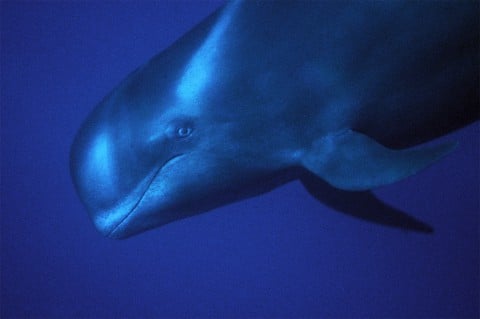
Pilot whales are easily recognised by their rounded head and the backward curved, rounded dorsal fin in the front half of their body. The juveniles have a weakly developed beak and their fin is more pointed, more erect and more like that of a dolphin. In the males the base of the dorsal fin is longer and it is larger overall. Pilot whales are dark grey, brownish or black with a diffuse lighter pattern on the back.
Population in Canary Islands:
In the lee of all islands (except El Hierro) with a central stable population in the southwest of Tenerife. A study there identified 636 specimens by their characteristic dorsal fins. Eleven stable groups or “pods” could be identified here. 117 of these animals were found at La Gomera, others at Gran Canaria and 11 were found there in comparisons with Madeira.

They are also common in the other islands, and the total population is estimated at 2000 animals in the Canary Islands. Mostly they prefer at least 400 m deep water far away from the coast. They mainly stay above depths around 1000 m, in summer they tend to stay further out.
Usually they form mixed groups of 10 to 20 animals with few males and more females and young, while in the “gatherings” in summer up to 100 animals meet.
Behaviour:
Pilot whales spend long resting periods “buoy-like” on the water surface to prepare and oxygenate themselves for hunting squid and fish at great depths. This makes them easy to observe as long as they are not disturbed. Usually some animals or the whole group dive together. The young often come up earlier or occasionally stay completely on the surface. Then you can observe the so-called “kindergarten groups” with few adults and several young animals.
The cohesion between the members of a herd is very noticeable. They do not separate their whole life long. Especially between mother and calf there are particularly intensive bonds.
Mating does not take place between members of the same group, but at meetings of different families.

During the resting phase, they breathe in and out calmly for a few minutes and refill their oxygen reservoir. When whale watching, it often seems as if the proximity of boats does not bother them. The whales continue to behave calmly, as in the photo in the background. (One should consider that the animals may be too tired to move away or even dive). The young animals approach the boats and “play”. They show one or both pectoral fins or lift their heads out of the water to peek. It is believed that they strike the surface with their flukes to attract attention.
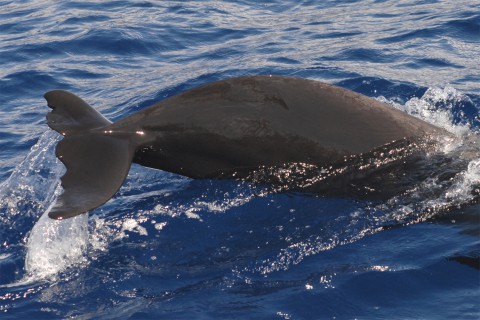
In some cases the boats approach too close or go too fast: then the pilot whales start to move, dive down or move away.
The babies (< ½ length of adults) usually swim close to the mother and the newborns (you can see the birth lines on the side) do not separate from her at all. At this age the risk of being attacked by a shark or other whales is very high.
On days with wind and waves you can occasionally see them surfing. Jumps are much rarer than with the dolphins already mentioned.
When the animals are sleeping on the water surface, everything is quiet if you “listen” with the hydrophone. When they “socialise” with each other, you can hear many clicks and whistles. Listen:
Life cycle:
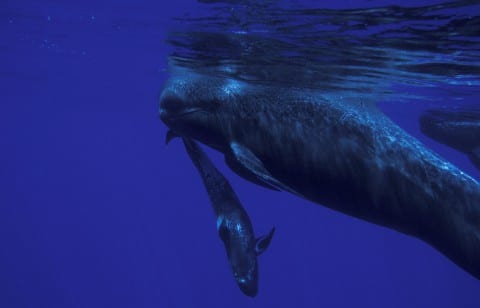
Most births take place in summer after a gestation period of 12 – 13 months, although newborns can be observed all year round. After 2 – 4 years they are weaned. Females become sexually mature at 7 – 12, males at 15 years. Males reach 46, females up to 64 years.
Here you can see a female with her stillborn baby. She tries to bring it to the surface to breathe and carries it around with her for up to 10 days.
Food
Pilot whales feed mainly on squid, which are preyed on in approximately 15-minute dives. In the literature the species Todarodes sagittatus and Megalocranchia sp. are mentioned. However, we have also found 10 cm thick tentacles on the surface of La Gomera next to the pilot whales, which could indicate that they also eat giant squid.
The whales dive at a speed of about 2 – 5 metres per second (m/s) down to 500 – 600 metres. There they slow down, orient themselves with clicks and start a fast hunt at 25 – 30 km/h, down to an average depth of 700 m.
If you compare this with the diving speeds of other species (2 m/s for sperm whales, 1.5 m/s for beaked whales), a new picture of such a “calm” pilot whale suddenly appears. During marking experiments by SECAC, a male could be observed between 9.00 and 16.00 hours during 17 consecutive dives at a depth of over 700 m! Even a juvenile of a little more than one year and a length of 2.20 m dived 10 times over 100 m deep and reached 370 m in one dive. The extreme energy expenditure and the many failed attempts are compensated by the high calorie content of the prey. This strategy has earned this species the nickname “cheetahs of the deep sea”.
The night dives only reach about 100 – 300 m, because the prey animals approach the more productive surface under cover of darkness at night.


